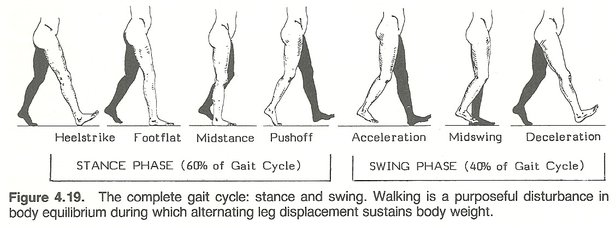|
www.golf360.blog
Putting and Distance Control (Part II) In ‘Putting: What is distance control?’ I discussed what ideal distance control is as it relates to the ball and green. In this post, I will tell you how you can create that ideal distance control and yes… it is as simple as walking. There are several different factors that influence distance control; ball position, the path of the putter head, angle of attack, face angle, CFC center face contact, etc. However, the most important determinant, and what has been developing since you could walk is the one that supersedes all others. While many golfers are told to focus on either ball position, putter head path, angle of attack, static loft, loft at impact, metronome cadence, etc. not one of these things are as important as the length of the putter in your ability to dial in your distance control. Let’s explore the reasons why… Since you developed the ability to walk as a toddler your body has developed its own cadence and within that cadence is your rhythm and tempo (rhythm is the synchronization of your stroke and tempo is the speed at which you perform the stroke). Through this development the body was teaching the brain (which is in contradiction to most thought processes) how to per form this act, especially as you reached your early to mid-20’s and the bodies structural growth cycle ended. If you watch anyone walk, or run, you will notice their arms swing in unison with their legs. Some swing them more than others and at varying speeds but everyone’s arms and legs move in sync as they walk. To observe this watch anyone walking down the street and you will notice they lift their arm a certain height before letting it fall. As it falls it will naturally reach a point where it is hanging directly from the shoulder; i.e. vertical. When the arm reaches vertical (it doesn’t stop at vertical but ascends in the opposite direction) the foot simultaneously connects with the ground. Regardless of the speed you walk this happens continuously without you having to think about it. SIDETRACK: For more on the arms and body’s ability to unconsciously know how to control distance consider the following excerpt from Geoff Mangum: “For most people, the arm is about 3 feet long from shoulder to fingertips. How long does the earth's physics take to swing a stick that long from top to top? A smidgen less than one second or 1,000 milleseconds, perhaps around 980 milleseconds. That's because a second (1,000 milleseconds) is the time required to swing a "meter stick" from top to top, and a meter stick is slightly longer (39.37") and slower than a human arm at 36", but not by much. Yes, each individual has a somewhat "unique" timing because each arm has a unique length, but that's dicing the matter too finely, and the reality is that the different lengths of adult human arms aren't all that different, and the overlap is very prominent among a random group of people.” Also from Geoff are some fantastic references from studies done on walking, stride lengths, Man’s system integration and more: THE WORLD TRAINS THE BRAIN, THE BRAIN LEARNS THE WORLD FOR SAFETY AND SUCCESS How? As you reached the end of your structural growth cycle, in your mid to early 20’s for most people, and your arms and legs stopped growing in length the brain went through what was most likely the last re-synchronization it would have to for your arms and legs to work together (or better yet the body informed the brain of the change in length and due to the constant speed at which each fell from a raised position; due to gravity, the tempo was recalibrated). It’s not something you were consciously aware of but what was happening was your brain was calculating how high to lift your arm so as it fell, and passed through its vertical position along the side of your body your foot was striking the ground. The only calculation required was how high should the arm be lifted to match that of the leg. NOTE: The arms and legs fall at a constant rate of speed due to that little thing known as gravity. SIDETRACK: This is why pre-teen and teens can often appear uncoordinated. Youths at this age do not always grow at a constant rate. Sometimes their legs outgrow the rest of their body (arms included) and the synchronization of the two is disrupted until the brain reconfigures the timing and resyncs them. Kids that were once very coordinated appear unable to walk as they are constantly tripping or stumbling. It’s the coordinating the upper limbs with the lower limbs that is the issue and as soon as the timing is restored their coordination returns. How does this relate to my putting? Ask almost anyone, ‘Who has poor distance control?’ and most will respond with 'It's not bad'. When I ask someone this question I often toss them a ball and ask them to toss it back, which they do without fail, often hitting me in the hands around my midsection, or very close to it. Each time we do this I back up a few steps and repeat this process and each time they toss the ball to my midsection. Why is tossing a ball so easy at these varying distances, yet putting to varying distances seems so difficult? Because when tossing a ball, the ball is resting in your hand prior to throwing it. When putting, you are doing so with a club, in essence a lever, and if that lever is the wrong length it will significantly throw off your body’s natural tendency to determine how high to lift your arm so that when it falls it does so with enough energy to propel the ball the correct distance to the hole. When a putter is the correct length, learning this becomes much faster for beginners and advanced players start to control their distance to such a degree that they can routinely reach the 1rps-4rps ideal speed I discussed in ‘Putting: Distance Control’. As mentioned above, your natural cadence was determined as your body informed your brain of a longer lever (your arm or leg) and your brain figured out how high to lift that lever so when each of them fell, they did so in unison. The same is true whether you’re tossing a ball or putting, in so far as all you have to do is understand how far to lift your arm and let gravity take it from there (it’s all done sub-consciously and free of thought). There’s no adding anything extra. You don’t have to: take it back half as far as you follow through, force acceleration into impact, or anything else (these are all conscious efforts). All you must do is let your arm and putter fall back to the ball. As a result of your body and brain being so well synced the correct length of the putter is imperative if this synchronization is to be maintained. If a putter is too short the hands will reach their finish position prior to the brain anticipating it and throughout the rest of the stroke; from the top of the stroke to impact and the forward stroke timing will be disrupted. If the putter is too long, the hand will not reach its finish position in the time the brain expects it to (the hand will arrive at it’s predetermined finish point too late as it reacts to the extra length of the putter), and as a result the timing will be disrupted. Even if you practice every day, if the putter is off by as much as a ½” your ability to control distance will be flawed. Many say, ‘I’ve been a _______ all my life and have great timing and eye hand coordination.’ And I don’t disagree that some people do have phenomenal eye/hand coordination. But, the best eye/hand coordination in the world cannot consistently perform an act that completely disrupts what the brain and body have done for years without manipulation; i.e. you can never learn to manipulate something consistently. Anything that goes against what your brain and body have coordinated for so long requires manipulation. When determining the length of your putter you need to understand the body’s ratios and understand how they play their part. For example, if Player A is 6’-1” but has a ratio greater than 2.5:1 between their leg length and arm length they will almost always require a longer putter than Player B that is 6'-4" but has less than a 2.5:1 ratio of legs to arms. (the legs are more than 2.5x longer than the arms) Although Player A is shorter the ratio of their legs is longer to their arms and overall height than Player B. When your legs are longer compared to your height the torso does not bend over as far and thus is further from the ground. As a result, you will require a longer putter. The rare exception is the player with exceedingly long arms. Player B’s legs maybe longer than Player A’s but because they are shorter in relationship to Player B’s overall height their torso will lean over more (coming closer to the ground) and their putter will have an increased chance to be shorter (especially in relationship to their height). Without knowing a person’s measurements or ratios, it is difficult to say if you’re 6’-1” you will need a 34.5” putter or if you’re 5’-6” you’re going to need a 31.75” putter. It’s not that easy and if anyone tells you it is that easy, they probably adhere to the theory that 4* of loft is ideal on your putter too. But that’s a post for another time. Here’s a simple way to measure yourself for putter length. Set up to a ball in as comfortable a position as you can. Your eyes should be over the ball and your body should be comfortably bent at the knees and hips. You should have enough tension to hold you in place but not so much that it is uncomfortable. Allow the upper arms to hang straight down from the shoulder sockets (as opposed to leaning back away from the ball). With your palms together you need two measurements; one from the middle of your palms vertically to the ground and second from the middle of your palms to the middle of the ball. These give you two sides of a 90* triangle and from there it’s as simple as the Pythagorean Theorem where A2 + B2 = C2. You have to add approximately 3” for the remaining part of your palm but the equation for length would be: Length = Square Root(AxA + BxB) + 3” Many of you will find your putter is too long and almost all of you will find your putter to be too flat. That is when you set up to your new length the heel of the putter will be off the ground. You will need to have your lie angle reset but knowing the formula for that is also a post for another time. Off the rack putters are overwhelmingly 35” in length (some are 34”) with a lie angle (the angle of the shaft up from horizontal) of 71* and a loft of 4*. This is the equivalent of all the shoe stores in the country carrying size 10 shoes with a few size 9’s. It’s telling everyone, regardless of build, ratio, etc. that they should use the same putter and when you have trouble controlling your distance and ultimately making putts you’re told to practice more. It’s a recipe for disaster, void of substance or understanding how the body and brain work together. It’s also one reason you are not lowering your scores. As I told one person with too many degrees on their wall; science works, but you have to utilize many sciences in this game and none of them take precedence over the brain body relationship. If they do take precedence, you won’t be playing very long because you’re soon going to damage something, most likely yourself. Getting the correct length of a putter will not itself make you a great putter. There are many other variables involved that also need to be in place. Understanding how your ability to improve your distance control is directly influenced by the length of a putter will at least allow you to stop looking in the mirror and blaming the person you see looking back at you. It makes you wonder if the person who came up with the phrase ‘It’s not the archer it’s the arrow’ was someone that didn’t understand what it took to improve the golfers they were working with; i.e. sometimes it is the arrow, NOT the archer because you will not ever control distance exceptionally well with a putter that is the wrong length. SIDETRACK The term ‘science’ is one of the most overused words in golf today. When I hear someone say ‘This is science.’ I ask them ‘Which discipline of science?’ If they are smart enough to answer with ‘Physics’ or ‘Ophthalmology’ my next question is ‘Do you think there is only one science in the game of golf?’ Unequivocally the answer is ‘no’ because there are many sciences that are at work be it a swing, stroke, etc. All of these sciences have to work in unison with one another or else the golfer or their game will wear out. The golfer wears out physically through unnecessary wear and tear on their body and mentally through a limited return on their time investment; i.e. they don’t see improvement even after hours, months and years of work. When proper instruction is given, it is done so with all these variables in mind and what will allow the golfer to improve in the quickest amount of time possible with the least amount of effort put in. It’s a phenomenon known as meta-learning. Ask anyone what science is and you will often get a blank stare as a response. The simple answer is, science is a form of measurement. It measures something, like a golf swing, and gives feedback but that feedback is based on prior measurements and what is known at that given time. If a certain result happens enough it turns into the model or theory of the day and may even be passed as a law. Even laws are susceptible to flaw. Where would we be if Einstein hadn’t stepped outside of the known science of his day? If he would have listened to his contemporaries and other accepted norms in the scientific world at the time he never would have developed his theory of relativity (E=mc2). One last thing about science. It is and can be a great thing that allows golfers, and society to continue to develop and reach new levels. However, science is a form of measurement where conclusions and predictions are developed. But what about the things that can’t be measured? Are we to dismiss them because we don’t know about them or how they can be measured? In the opinion of this author this is where we come to the differences in science and applied science. Science is what many believe the outcome will be, again based on past measurements and a measurement of past measurements to determine the outcome. Applied science is the real-world application of the discipline its relating too; i.e. sometimes things happen outside of what everyone thinks and that happens when all the variables cannot be measured or are known. Science can be and is a great thing, don’t get me wrong. It just isn’t the end all when it comes to golf or life and anyone that tells you it is hasn’t been around enough to see the flaw of their beliefs. THANK YOU for reading this article. If you found it interesting and helpful please do us a favor and send it to a friend so they can enjoy it too. Copy the link and email to them, it's that easy or share it to your social media by pressing any of the buttons to the left of the screen. If you were sent the link to this article you can sign up to receive more creative ways to improve your game and life by visiting out home page and registering yourself or you can click the 'SUBSCRIBE' button at the lower right. QUESTION OF THE DAY: What questions or thoughts do you have about controlling distance in putting? Please let us know in the comments. Comment Rules: Everyone has an opinion and can voice it in the 'Comments' section below. However, respect is a must. If you choose to be disrespectful your post will be deleted. Please refrain from adding URL's and use your personal name NOT your school/business name. Enjoy yourself and thank you for adding to the discussion.
1 Comment
John
7/2/2019 07:30:09 pm
I've realized that getting fitted for a putter makes sense. Your article on putter length was insightful and I look at your other articles before I choose someone to trust with fitting me for a new putter. Many Thanks
Reply
Leave a Reply. |
Archives
July 2024
Categories
All
|
|
Connect with the Golf Paradigm:
@ Old South Golf Links 50 Buckingham Plantation Dr Bluffton, SC 29910 843.338.6737 [email protected] |
Click to set custom HTML
|




 RSS Feed
RSS Feed

